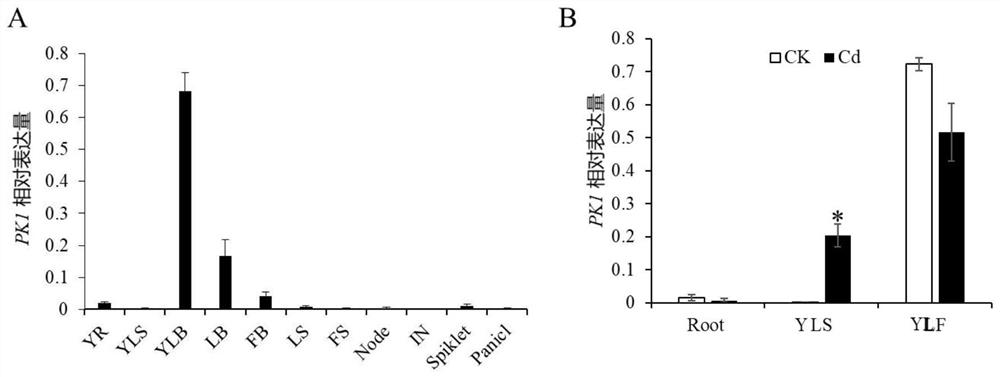Gene PK1 for regulating and controlling cadmium accumulation of rice as well as protein and application of gene PK1
A rice and gene technology, applied in the fields of biotechnology and environment, can solve problems such as the inability to meet the needs of production practice, and achieve the effect of not losing soil fertilizer efficiency
- Summary
- Abstract
- Description
- Claims
- Application Information
AI Technical Summary
Problems solved by technology
Method used
Image
Examples
Embodiment 1
[0032] A gene PK1 that regulates the accumulation of cadmium in rice was found in rice, the gene number is Os12g0632900, and its CDS nucleotide sequence is shown in SEQ ID NO: 1. The protein encoded by this gene PK1 (a rice receptor protein) The amino acid sequence of kinase) is shown in SEQ ID NO:2.
[0033] 1. Construction of PK1 mutant pk1
[0034] To study the role of PK1 in rice, we used gene editing technology to obtain three homozygous mutants 10250-12, 10250-15, 10250-17 ( figure 1 ). The forward primer of the gene editing target sgR-PK1 is GGTGGTGGCGGAGGCGGCAT (its nucleotide sequence is shown in SEQ ID NO: 3), and the reverse primer sequence is ATGCCGCCTCCGCCACCACC (its nucleotide sequence is shown in SEQ ID NO: 4) ), the pair of primers were complementary in vitro to form a double-stranded clone into the intermediate vector, and then cloned into the target vector P1300 (obtained from University of California, San Diego, US) by enzyme digestion to obtain the target...
Embodiment 2
[0055] An application of using the gene PK1 that regulates the accumulation of cadmium in rice or its encoded protein in remediating soil cadmium pollution, namely a method for remediating soil cadmium pollution, comprising the following steps:
[0056] The method of Example 1 was used to cultivate cadmium-contaminated remediation rice (that is, the homozygous mutant of rice pk1 in Example 1), planted in polluted rice fields with a soil cadmium content of 0.5 μg / g dry weight, and used suitable for cadmium pollution in southern hilly areas after maturity. The high amount of rice straw and stubble was removed from the field and harvested with integrated agricultural machinery. After two consecutive years of planting, the soil cadmium content decreased by 30%, and the soil cadmium content in the paddy field became 0.35 μg / g dry weight, indicating that the pk1 mutant The material has a very good repair effect.
Embodiment 3
[0058] An application of utilizing the gene PK1 that regulates the accumulation of cadmium in rice or its encoded protein in rice yield regulation, nitrogen utilization or genetic improvement of root system configuration, comprising the following steps:
[0059] The method of Example 1 was used to cultivate rice pk1 homozygous mutants. After research, it was found that PK1 also had a significant impact on rice growth and development, yield per plant and nitrogen use efficiency at different growth stages of rice. For example, in the 4-week hydroponic seedling period, compared with the wild-type ZH11, the root system configuration of the pk1 mutant was significantly changed, and the plant height and main root length were significantly reduced ( Figure 7 ); the total nitrogen content increased, but the nitrogen physiological utilization efficiency decreased ( Figure 8 ). The yield per plant at maturity was significantly lower than that of wild-type ZH11 ( Figure 9 ). These...
PUM
 Login to View More
Login to View More Abstract
Description
Claims
Application Information
 Login to View More
Login to View More - R&D
- Intellectual Property
- Life Sciences
- Materials
- Tech Scout
- Unparalleled Data Quality
- Higher Quality Content
- 60% Fewer Hallucinations
Browse by: Latest US Patents, China's latest patents, Technical Efficacy Thesaurus, Application Domain, Technology Topic, Popular Technical Reports.
© 2025 PatSnap. All rights reserved.Legal|Privacy policy|Modern Slavery Act Transparency Statement|Sitemap|About US| Contact US: help@patsnap.com



